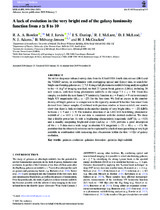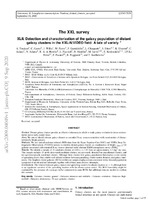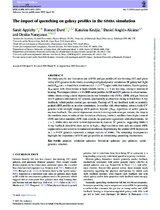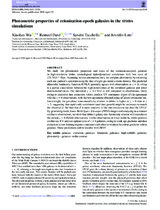A lack of evolution in the very bright end of the galaxy luminosity function from z 8 to 10
| dc.contributor.author | Dunlop, J. S. | |
| dc.contributor.author | Bowler, R. A. A. | |
| dc.contributor.author | Jarvis, M. J. | |
| dc.date.accessioned | 2021-02-11T06:55:07Z | |
| dc.date.available | 2021-02-11T06:55:07Z | |
| dc.date.issued | 2020 | |
| dc.identifier.citation | Dunlop, J. S. et al. (2020). A lack of evolution in the very bright end of the galaxy luminosity function from z 8 to 10. Monthly Notices of the Royal Astronomical Society, 493(2), 2059–2084 | en_US |
| dc.identifier.issn | 1365-2966 | |
| dc.identifier.uri | https://doi.org/10.1093/mnras/staa313 | |
| dc.identifier.uri | http://hdl.handle.net/10566/5897 | |
| dc.description.abstract | ABSTRACT We utilize deep near-infrared survey data from the UltraVISTA fourth data release (DR4) and the VIDEO survey, in combination with overlapping optical and Spitzer data, to search for bright star-forming galaxies at z ≳ 7.5. Using a full photometric redshift fitting analysis applied to the ∼6 deg2 of imaging searched, we find 27 Lyman break galaxies (LBGs), including 20 new sources, with best-fitting photometric redshifts in the range 7.4 < z < 9.1. From this sample, we derive the rest-frame UV luminosity function at z = 8 and z = 9 out to extremely bright UV magnitudes (MUV ≃ −23) for the first time. | en_US |
| dc.language.iso | en | en_US |
| dc.publisher | Oxford University Press | en_US |
| dc.subject | Galaxies: evolution | en_US |
| dc.subject | Galaxies: formation | en_US |
| dc.subject | Galaxies: high-redshift | en_US |
| dc.subject | Bright star-forming galaxies | en_US |
| dc.subject | Photometric redshift | en_US |
| dc.title | A lack of evolution in the very bright end of the galaxy luminosity function from z 8 to 10 | en_US |
| dc.type | Article | en_US |




